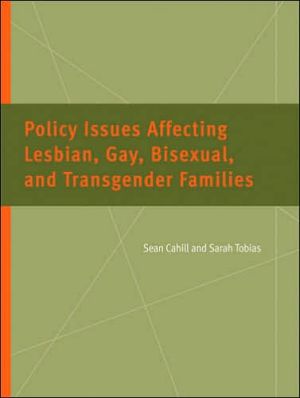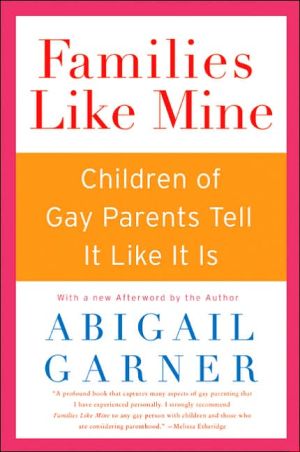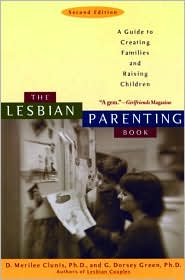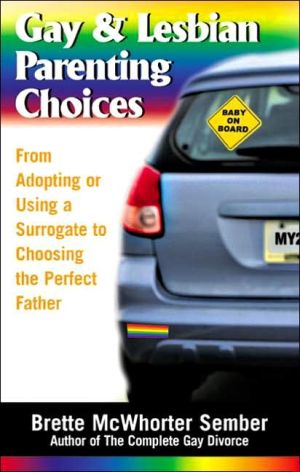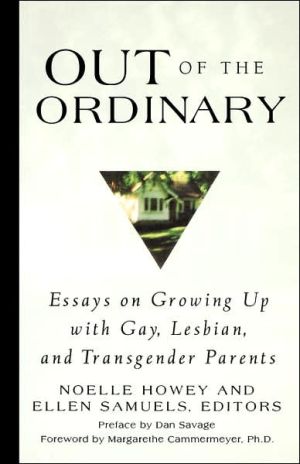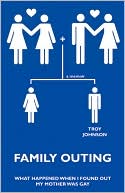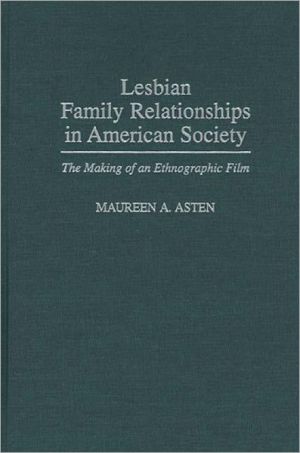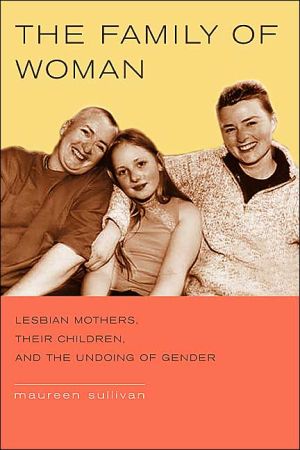Policy Issues Affecting Lesbian, Gay, Bisexual, and Transgender Families
Lesbian, gay, bisexual, and transgender people face the same family issues as their heterosexual counterparts, but that is only the beginning of their struggle. The LGBT community also encounters legal barriers to government recognition of their same-sex relationships and relationships to their own children. Policy Issues Affecting Lesbian, Gay, Bisexual, and Transgender Families addresses partner recognition, parenting, issues affecting children of LGBT parents, health care, discrimination,...
Search in google:
Lesbian, gay, bisexual, and transgender people face the same family issues as their heterosexual counterparts, but that is only the beginning of their struggle. The LGBT community also encounters legal barriers to government recognition of their same-sex relationships and relationships to their own children. Policy Issues Affecting Lesbian, Gay, Bisexual, and Transgender Families addresses partner recognition, parenting, issues affecting children of LGBT parents, health care, discrimination, senior care and elder rights, and equal access to social services. Sean Cahill and Sarah Tobias provide up-to-date, accurate analysis of the major policies affecting LGBT people, their same-sex partners, and their children. This valuable resource offers literature reviews of demographic research as well as original research based on the U.S. Census same-sex couple sample. It also provides a look at the 30-year history of right-wing anti-gay activism and the intra-community intellectual debates over the fight for marriage. "The sheer diversity of gay people and opinion shines through Cahill and Tobias's fact-packed depiction of same-sex couples and their kids, their needs and day-to-day challenges, and the movement for fairness and the freedom to marry. The disparate personal stories and struggles in this informative book underscore the importance of ending discrimination in marriage and ensuring that no family is left behind."—Evan Wolfson, Founder and Executive Director of the Freedom to Marry Project "A concise, comprehensive guide to gay-family issues that combines an impassioned progressive sensibility with a firm respect for facts."—Jonathan Rauch, senior writer and columnist for National Journal, Atlantic Monthly correspondent, and author of Gay Marriage: Why It Is Good for Gays, Good for Straights, and Good for America "Cahill and Tobias offer readers a thorough and immensely readable guide to the legal problems faced by LGBT families."—Ellen Andersen, Indiana University–Purdue University at Indianapolis "For an account of policy issues that frame lesbian, gay, bisexual, and transgender (LGBT) family lives here in the United States, one need look no further. Sean Cahill and Sarah Tobias supply accurate and up-to-date information about the legal and policy contexts of LGBT lives across the country. This book is sure to be a valuable resource for students and scholars, as well as for others seeking to understand and challenge discrimination based on sexual orientation or gender identity."—Charlotte J. Patterson, University of Virginia Sean Cahill is Director of the National Gay and Lesbian Task Force Policy Institute. Sarah Tobias is a feminist theorist and LGBT activist who earned her Ph.D. in Political Science from Columbia University. She has taught Political Theory at colleges in New York and New Jersey, and currently works as Senior Policy Analyst in the Democracy program at Demos, a New York City–based think tank.
POLICY ISSUES AFFECTING LESBIAN, GAY, BISEXUAL, AND TRANSGENDER FAMILIES\ \ By Sean Cahill Sarah Tobias \ THE UNIVERSITY OF MICHIGAN PRESS\ Copyright © 2007 University of Michigan\ All right reserved.\ ISBN: 978-0-472-03061-3 \ \ \ \ Chapter One\ INTRODUCTION \ Eugene Clark and Larry Courtney lived like many married couples, creating their lives around each other and being recognized by their families and friends as a committed couple. When Larry was offered a job in New York City in 1988, the couple relocated from Washington, D.C., and Eugene found a new position in New York. When New York City created a domestic partnership registry, the couple went to City Hall to get the closest thing to a marriage certificate available to them. When Eugene's mother became ill, they brought her from D.C. to their one-bedroom Manhattan apartment so that they could care for her during the last years of her life.\ On September 11, 2001, Eugene was one of the thousands at the World Trade Center who did not come home to their loved ones that evening. Larry received a voice mail from Eugene after the first building was hit: "Don't worry, the plane hit the other building. I'm okay. We're evacuating." That was the last time Larry heard from him. Like other people who lost family members that day, Larry reported Eugene missing and filled out his death certificate and the workers' compensation forms. However, Larry was informed that since he and Eugene were not legally married, he was not considered family. The compensation would go to Eugene's father, with whom Eugene had not spoken in over twenty years.\ In the midst of his intense grief, Larry had to counter this claim that he and Eugene were not family, even though they had built a life together for fourteen years. Larry joined with Lambda Legal Defense and Education Fund to educate the public, the media, and legislators about this unjust situation. On August 20, 2002, the New York State Assembly passed a bill giving the domestic partners of September 11 victims full spousal rights to workers' compensation.\ Unfortunately, this type of situation is far from uncommon for same-sex couples and their families. Larry Courtney's predicament was addressed in part because his life partner Eugene was killed in an attack of international significance. Although the resulting 2002 bill marks an important victory, most lesbian, gay, bisexual, and transgender (LGBT) families remain routinely discriminated against by public policy. These injustices are usually not linked to a high-profile national tragedy, and these families' stories usually do not make it to the evening news. Nevertheless, many LGBT people experience personal tragedies-such as the death of a life partner-that are compounded by a callous disregard of their family bonds. As a result, they suffer emotionally, economically, and personally.\ Family policy affects LGBT individuals and influences their security and well-being throughout their lives-from childhood through young adulthood, middle age through older years, and even after death. Much public policy is based on the goal of promoting "the family," recognizing the economic and emotional interdependence of family members and giving special priority to this bond. Yet policy has historically been based on a narrow definition of family that does not encompass the bonds of LGBT people. Most policy gives preference to heterosexual married couples and their children over all other family formations. Thus, unmarried couples (both same-sex and opposite-sex), single parents, extended-family caregivers, and the children of these families are all disadvantaged. Homophobia and heterosexism compound this problem for LGBT families. Consequently, LGBT people are left with little security for their relationships, especially in times of hardship or transition.\ This book will provide a comprehensive account of the discrimination that LGBT families confront. It will explore how policy changes could make LGBT families more secure. It will pay particular attention to the current political debate over how to recognize same-sex couple families.\ The issue of whether or not same-sex couples should be allowed to access the institution of civil marriage emerged as a major national political controversy in the mid-1990s. During this time, same-sex relationships were decried by congressional conservatives as a threat to an abstract construct of "the family"-the heterosexual, married, and economically sustainable family-which was posited as "the backbone of this country" by Representative Bob Barr (R-GA) in 1995 and as "one of the essential foundations on which our civilization is based" by Representative Charles Canady (R-FL) in 1996. In congressional debate on July 12, 1996, Representative Barr, the architect of the 1996 Defense of Marriage Act, argued:\ [A]s Rome burned, Nero fiddled, and that is exactly what [supporters of same-sex marriage] would have us do ... The very foundations of our society are in danger of being burned. The flames of hedonism, the flames of narcissism, the flames of self-centered morality are licking at the very foundations of our society: the family unit.\ Ironically, in the summer of 1996, congressional conservatives portrayed low-income single mothers and cohabiting unmarried heterosexual couples as selfish and narcissistic for not getting married, while those same conservatives concurrently denounced gay and lesbian couples as self-indulgent narcissists for seeking to get married. Gay and lesbian families seeking legal protections were portrayed as a threat to Western civilization and God. Representative Canady stated, "we as legislators and leaders for the country are in the midst of a chaos, an attack upon God's principles." Representative Ron Packard (R-CA) argued, "throughout history, civilizations that have allowed the traditional bonds of family to be weakened, these civilizations have not survived."\ Anxieties related to gay couples seeking legal protections surfaced again in December 1999, when Vermont's high court ruled that same-sex couples required equal treatment under state policy. But backlash against the advances of gay people reached a peak in 2003-4, following a number of key court rulings in the United States and Canada striking down archaic sex "sodomy" laws and legalizing civil marriage for same-sex couples. Through the debate about gay marriage, many claims have been made about gay and lesbian people and their families. Anti-gay marriage activists and elected officials have also targeted gay and lesbian parenting, safe schools initiatives, and nondiscrimination laws protecting against anti-gay and anti-transgender discrimination.\ The main chapters of this book can be divided into two discussions. In chapters 2 and 3, we provide an overview of what is known about LGBT families and the policy issues affecting them-ranging from discrimination to domestic partnership, from health insurance access to family and medical leave. In chapters 4 and 5, we focus on the recent political and intellectual history that frames the struggle over LGBT family policy-a struggle that occurs within the LGBT movement itself, as well as between supporters and opponents of legal equality for LGBT people.\ In chapter 2, we summarize what is known about LGBT people and their families. We review recent U.S. Census data pertaining to the households of same-sex couples, paying particular attention to parenting data, including parenting data about people of color in same-sex relationships. We provide an overview of issues of adoption, foster care, and reproductive technology that affect LGBT families. We also address the unique situation of LGBT youth, who are at greater risk than other youth of experiencing homelessness, suicide, and violence and who are often unable to find support at school or in their families. We discuss the particular family issues facing LGBT elders, including unequal treatment under income support programs and Medicaid. We also consider the way in which major health-related issues-such as health insurance access, decision making, unpaid leave from work, nursing care, and domestic violence-relate to LGBT family policy.\ In chapter 3, we address the options available to policymakers for recognizing same-sex relationships. We discuss civil marriage, civil unions, domestic partnerships, and reciprocal beneficiary relationships. We explore the international trend toward recognizing same-sex unions, and we provide an overview of recent court decisions in the United States and Canada that have major implications for public policy affecting LGBT families.\ In chapter 4, we explore the intellectual history of the internal debates regarding family recognition within the LGBT movement. We show how marriage has historically been a controversial and contested terrain for gay men and lesbians. We discuss the hostility of radical feminism toward marriage, and we discuss the gay rights movement's early acknowledgment that gay liberation will only be achieved as a by-product of women's liberation. We explore queer theorists' claims that marriage constitutes a divisive and exclusionary form of moral regulation that should be shunned. We also address the way in which some LGBT legal scholars have sought to define family expansively in terms of functional relationships. About a decade into the AIDS epidemic, some conservative voices in the LGBT movement started to write about marriage as a means to reject so-called queer values, promote monogamy in gay relationships, and stabilize gay life; we discuss these arguments. Finally, we describe how the struggle for family recognition was reframed during the 1990s as a civil rights strategy to combat discrimination.\ In chapter 5, we argue that the gay marriage issue has become central in contemporary U.S. politics in large part because anti-gay activists from the religious right have successfully deployed gay rights controversies as divisive social issues since the early 1970s. Since the mid-1990s, the main focus of anti-gay politics in the United States has been opposition to civil marriage by same-sex couples. Social conservatives have consistently argued that expanding the institution of marriage to include gay and lesbian couples would undermine "the family," constructed as exclusively heterosexual. Chapter 5 examines the recent political history of the struggle for marriage equality by same-sex couples and the backlash evoked by such advances as the Massachusetts high court ruling of 2003 legalizing marriage for gay couples. It also examines the Massachusetts-based Coalition for Marriage, a network of national and local religious right groups that seeks to ban any type of partner recognition for gay couples in Massachusetts. The Coalition for Marriage is an example of the kinds of political coalitions being formed by the Christian right in America. In addition, chapter 5 reviews the role the marriage issue played in the 2004 presidential election.\ In chapter 6, we consider the extent to which the pursuit of same-sex marriage is currently reflective of the priorities of the LGBT community. Some LGBT intellectuals continue to argue that marriage itself is a regressive or antidemocratic institution that should be abolished or supplemented with other forms of partner recognition. Many other voices of dissent within the LGBT community question the movement's focus on marriage. In addition to faulting the flaws of the institution, they argue that too many resources have been devoted to the marriage issue to the detriment of other concerns, such as anti-LGBT hate violence, anti-LGBT discrimination in employment and housing, and other basic concerns. Although many black gay people support marriage equality, some members of the African American community have expressed anger at the usurpation of civil rights discourse by LGBT whites. Gay activists argue, however, that the LGBT community must defend itself against the attacks of the anti-gay movement. This is also a critical opportunity to educate straight America about the real experiences facing same-sex couple families. Finally, several recent surveys indicate that marriage and partner recognition is a top priority of LGBT people, including LGBT people of color.\ We intersperse chapters 2 and 3 with case studies illustrating the difficulties regularly confronted by same-sex couples whose family bonds are not recognized. The rights, responsibilities, protections, and peace of mind afforded couples through family recognition become particularly important in times of crisis. For example, Hillary Goodridge, one of the lead plaintiffs in the Massachusetts same-sex marriage case Goodridge v. Dept. of Public Health, reported encountering a "nightmare" after her partner Julie Goodridge gave birth to their daughter Annie. Her account was reported in the Boston Globe.\ After Annie emerged from Julie Goodridge's womb by cesarean section with lungs full of liquid, the infant was rushed from the operating room into intensive care, put on a ventilator and strapped to splints with intravenous tubes inserted in her tiny arms. As Julie's lesbian partner, Hillary, ran frantically from floor to floor between the neonatal unit and post-op where doctors were sewing up Julie, she was barred at different times from both Julie's and Annie's bedsides by hospital staff because she wasn't legally connected to either. She eventually saw both-by tearfully pleading with a nurse in one instance and telling staff she was Julie's sister in another-but the experience later fueled the couple's determination to make marriage an option for gays and lesbians like themselves.\ This book is intended for those interested in better understanding same-sex couple families in the United States, as well as other LGBT families. We hope that, as a result of reading this book, more people will challenge the discrimination LGBT families face in public policy. In highlighting these areas, it is our hope that we can help researchers, policymakers, and fellow Americans more clearly define areas of need and promote policies to respond to them. If changed uniformly, family policy would result in a world much more responsive to the economic, legal, and social issues LGBT people face in building and sustaining the relationships with those dearest to them-with their partners, their children, their families.\ Chapter Two\ LGBT FAMILIES AND THEIR POLICY NEEDS \ WHAT DEFINES A FAMILY?\ Most people in the United States consider a family to be "a group who love and care for each other," defining the term "in emotional, rather than legal or structural terms." In the LGBT community, as in the larger community, these families take many forms. They include\ a same-sex couple living alone, with other family, or with friends;\ a same-sex couple with children from previous relationships or adopted or conceived during their relationship;\ a single parent raising a biological child or biological children, an adopted child, or a relative's child;\ individuals living with their families of origin or with their "families of choice," such as close friends who serve essential caregiving functions;\ multiple parent networks consisting of, for example, two couples or one couple and an individual who are raising children together;\ aunts, uncles, or grandparents raising their nephews, nieces, or grandchildren.\ Although the public largely believes that a family is something more than a legal relationship and that caring for one another transcends legal boundaries, the vast majority of the policies that govern people's lives define family as a legal unit comprised of a married man and woman with their own biological or adopted children. This assumption underlying family policy does not reflect the contemporary demographic reality of American families. Almost one-third of families with children in the United States are headed by either single parents or two unmarried, cohabiting parents. There are significant differences among racial and ethnic groups. Single parenting is much more prevalent among black and Latino parents than among white non-Hispanics. Black families with children are nearly four times as likely as white non-Hispanic families with children to be headed by single or unmarried parents. Hispanic families with children are two-and-a-half times as likely as white non-Hispanic families with children to be headed by a single or unmarried parent.\ Approximately 44 percent of adults in the United States are unmarried. According to the 2000 U.S. Census, married heterosexual couples with children comprise less than one-quarter of American households. The 2000 U.S. Census found nearly 1.2 million men and women living with an unmarried partner of the same sex, or some 594,391 same-sex couples.\ Studies show that most lesbians and gay men aspire to have committed, loving relationships and want a stronger sense of family in their lives. Although demographic research on lesbian, gay, and bisexual people is limited and most national surveys do not ask about sexual orientation, there is a significant body of research from which we can discern some trends. A series of studies from the 1970s to the 1990s found that between 64 and 80 percent of lesbians and between 46 and 60 percent of gay men report that they are in committed relationships with another person of the same sex. Studies show that same-sex relationships are comparable to opposite-sex relationships in terms of quality and satisfaction in the relationship. Contrary to common misconceptions, many same-sex couples are raising children, as are thousands of single lesbian and gay parents. Bisexuals and transgender people are found in both opposite-sex and same-sex relationships.\ (Continues...)\ \ \ \ \ Excerpted from POLICY ISSUES AFFECTING LESBIAN, GAY, BISEXUAL, AND TRANSGENDER FAMILIES by Sean Cahill Sarah Tobias Copyright © 2007 by University of Michigan . Excerpted by permission.\ All rights reserved. No part of this excerpt may be reproduced or reprinted without permission in writing from the publisher.\ Excerpts are provided by Dial-A-Book Inc. solely for the personal use of visitors to this web site. \ \
Contents 1. Introduction....................12. LGBT Families and Their Policy Needs....................73. Legal Protections for Families and Children....................554. The Intellectual History of Family: A Contested Discourse within the LGBT Movement....................835. Recent Political History: The Struggle for Partner Recognition and the Right-Wing Backlash....................1016. Conclusion....................133Notes....................145Selected Bibliography....................165Index....................171
